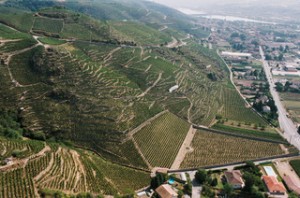Guigal and Château d'Ampuis
A version of this article first appeared in Winestate magazine, Sept/Oct 2010, updated Feb 2011.
The Guigal name is one of the most famous names in French winemaking, despite the family firm being founded as recently as 1946, in Ampuis, at the heart of the Côte-Rôtie appellation in the Rhône valley.

Guigal's Côte Blonde
The Guigal family story is one of hard graft, as well as poetic circles of life. Third generation Philippe took over as general manager when he was just 22. Such youthful responsibility is a hallmark of the Guigal family. Philippe’s grandfather Etienne, the company’s founder, started work at 14 as a vineyard worker for Rhône merchant Vidal-Fleury. He only set up his own business fifteen years later, having worked his way up to be the general manager of Vidal-Fleury.
Many years later, in 1984, the Guigals bought Vidal-Fleury, which had latterly fallen into something of a decline. That company now is run as a separate and independent company, with a completely different team.
Philippe’s grandmother, Marcelle, also started work as a young teenager, as a housemaid at Château d’Ampuis, which was at the time the summer residence of wealthy silk traders.
Even more years later, in 1995, the Guigals bought the Château d’Ampuis. By then the Château was run down, and had been empty for five years. The family spent the next 11 years painstakingly restoring the house.
The origins of this once-again impressive building date to a 12th century fort, which was subsequently expanded into a Renaissance château in the 16th century. Fully restored, it is now an historical monument.
Being able to use the word Château on the wine label proved quite tricky. Philippe said “the notion of château is very restricted. We looked for the original archives of Château d’Ampuis. In the 16th century the Château was producing wine using some vineyards. Today we own the same vineyards and the Château. We wanted to rebuild the link with the building and the vineyard.
“The vineyard parcels had never changed their names. There is almost eight hectares, a mix of Côte Brune and Côte Blonde [in Côte-Rôtie]. Three vineyards are touching La Turque, one is touching La Landonne and three are close to La Mouline.” Because the family proved the link between vineyard and Château they were given permission to use the term.
The wine Château d’Ampuis has notably less ageing than the Guigal’s uber-famous Côte-Rôtie cuvées of La Mouline, La Landonne and La Turque, 38 as opposed to 42 months. Philippe said Château d’Ampuis “has a mix of terroirs. Because Côte Blonde are delicate, seductive, we consider the oak impact is greater than in single vineyard, so the ageing is a little shorter. We don’t want oak to overpower the wine.”

Philippe and Marcel Guigal
Château d’Ampuis also houses the Guigal’s cooperage, which the family started in 2003, when Philippe’s father Marcel turned 60. It had long been a dream of his to have a cooperage.
Philippe said “starting a cooperage by ourselves would have been very difficult. We were helped by [prestigious coopers] Seguin Moreau. We were sourcing 100% from Seguin Moreau, but now we do have other sourcing as well. For example we went directly to the forest to buy Tronçais [oak], and are using this now.”
A lone cooper works in 15th and 16th century buildings of the Château crafting five barrels a day. This provides the 750 to 800 new oak barrels needed by the Guigals. Philippe said “we use them all for our own vineyards. We sell only second hand barrels.” He added “we will need more barrels in the future, maybe also for Vidal-Fleury, so we may have to think about a second cooper in the winery.”
The family wanted more control of the oak they use. Philippe said “we dry [the staves] for three years. It’s a natural drying, without watering. If you water, [the seasoning of the staves] goes faster. If you wait for natural rain, it takes more time. There’s already a change in the wine. We’ve noticed it on the quality of the whites, the oak touch is much more gentle.”
The Guigals use only the traditional 228 litre pièce of the region. A barrique, as is traditional in Bordeaux, is 225 litres. Philippe explained “in barrique the width of the stave is smaller, in pièce they are bigger. It is better for syrah to have larger staves. We think the oxygenation through the staves is slower in pièce than barrique.”

Eve and Philippe Guigal
They prefer to handle the reductive tendencies of syrah through precise rackings. Philippe said “we do two to three rackings in the first year depending on the malo, which we do in the pièce. Two rackings in the second year; one racking in the third year.” And for the wines that have 42 months’ ageing, there is no racking in the final year. These wines are bottled without fining or filtration.
As if all this were not enough, another circle of life is beginning for the Guigals. Philippe and his wife Eve are the proud new parents of twin boys Charles and Etienne, born at the end of 2010. Sometimes it can be as well to keep your own parents close at hand…
Comments
One Response to “Guigal and Château d'Ampuis”




March 1, 2013 at 12:40 am
We celebrated with a lovely bottle of your E. Guiga, Cotes Du Rhone wine which was excellent! We are traveling to the south of France in April for 3 months just to explore as my mother’s family (Laffoon, Lafon) come from that area. I hope we will be able to visit the winery. Our best regards, Villa Kerr, USA